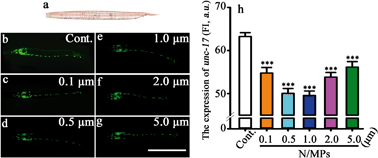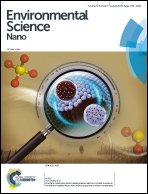Polystyrene (nano)microplastics cause size-dependent neurotoxicity, oxidative damage and other adverse effects in Caenorhabditis elegans†
Abstract
(Nano)microplastics (N/MPs) are emerging contaminants of increasing concern. However, little is known about the potential toxicity difference between nanoplastics and microplastics on organisms. In this study, we investigated the effects of polystyrene N/MPs with diameter sizes of 100 and 500 nm at the nanoscale and 1.0, 2.0 and 5.0 μm at the microscale on the survival, lifespan, motor behavior, movement-related neurons and oxidative stress in Caenorhabditis elegans. After 3 days of exposure to 1.0 mg L−1 polystyrene particles of the five sizes, the 1.0 μm group had the lowest survival rate, the largest decrease in body length and the shortest average lifespan in nematodes. We demonstrated that exposure to N/MPs accelerated the frequency of body bending and head thrashing, and increased crawling speed, which indicate that N/MPs can induce size-dependent excitatory toxicity on locomotor behavior. Of the five sizes of N/MPs, 1.0 μm particles significantly downregulated the expression of unc-17 and unc-47, and resulted in obvious damage to cholinergic and GABAergic neurons. We also found that polystyrene N/MPs significantly elevated the expression of gst-4, which encodes glutathione S-transferase-4, a key enzyme in oxidative stress. Additionally, N/MPs-induced oxidative damage was effectively attenuated by natural antioxidants, curcumin and oligometric proanthocyanidins. Taken together, these findings suggest that (nano)microplastics can exert size-dependent toxicity and have extensive impacts on organisms.



 Please wait while we load your content...
Please wait while we load your content...